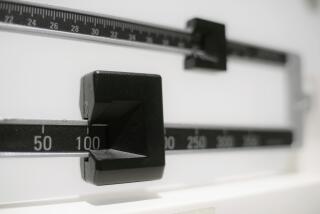The food journal: A little tech could make it stick
- Share via
You already know you should keep a food journal if you want to lose weight, right?
So why don’t you do it?
One weight-loss expert thinks he knows the answer.
“It’s just not sexy enough,” said J. Graham Thomas, a research professor at Brown Alpert Medical School who helps oversee the National Weight Control Registry, the nation’s longest-running weight-loss research study. “It can feel like homework.”
The registry studies thousands of Americans who have maintained weight loss for at least one year and looks for common denominators that can help the public.
Photos: 17 ways to fight the inertia, step by step
And that’s where food journaling comes in.
“It’s extremely effective,” Thomas said. “One of the best ways to predict how much weight someone is going to lose is how well they adhere to the self-monitoring protocol.”
That’s good news for people who aren’t thrilled about dieting or going to the gym. Just carefully logging your food intake is enough to build up the kind of awareness that will help you bypass those M&Ms in the office candy jar.
#LATfit: 52 ways to leave your blubber
“People are shocked by what has a lot of calories, what has a lot of fat and carbohydrates,” Thomas said. “They just have no idea. They think they’re dieting. Once they have that awareness, it’s easier to say no.”
Also good news: the seemingly endless array of free online food journals and smartphone apps that keep track of your favorite foods and recipes. (In the old days, you needed pen and paper, a calculator and a food calorie guide. Talk about homework!) Many apps can instantly upload a product’s nutritional information by scanning its barcode.
Choosing an online or mobile food journal is mainly a matter of personal preference. Here, we highlight three free services that we like. (Many offer premium memberships, but you get all the basics with the free versions.) Do not hesitate to try them all out to find the one that suits you. After all, the best food journal for you is the one you will actually use.
Lose It!
https://www.loseit.com
Why we’re fans: Especially easy for those who like to know what percentage of carbs, proteins and fat they are taking in, such as adherents to the Zone Diet’s 40-30-30 approach. Allows you to easily duplicate meals and foods from one day to the next, convenient for people who tend to eat the same meals day-to-day. If you enjoy community support, Lose It! encourages accountability through challenges, forums and more, and can email weekly progress reports, if you like that sort of thing. Logs your workout activities as well. Especially easy to navigate on a smartphone.
My Fitness Pal
https://www.myfitnesspal.com
Why we’re fans: One of My Fitness Pal’s strengths is its hefty catalog of foods. The website claims more than 2 million foods, and it shows. Like many other food journals, it boasts the ability to connect to a variety of fitness trackers, such as the Fitbit. That allows you to easily calculate calories burned, steps taken, etc., and how that offsets calories consumed. (Remember, though, to take calories burned with a grain of, um, salt. Many such calculations are based on an average.) If you are manually inputting your exercise, My Fitness Pal has lots to choose from, including Wii games.
My Plate
https://www.Livestrong.com
Why we’re fans: The Livestrong brand has been tarnished a bit by you-know-who. But moving on: My Plate offers an easy-to-use, at-a-glance dashboard, where some of the other applications require a few more clicks to get the same data. It also includes an impressive database of exercises and calories burned, among them: indoor skiing. But the true benefit of My Plate is the Livestrong website. Click around on the site, with its real-time take on nutritional news and array of motivational articles, and you’ll find yourself jumping up off the couch and heading out the door for a workout.
ALSO:
L.A. Walks: Gates reopen for Lake Hollywood strolls
Going gluten-free more common, but not necessarily easier
More to Read
Eat your way across L.A.
Get our weekly Tasting Notes newsletter for reviews, news and more.
You may occasionally receive promotional content from the Los Angeles Times.










